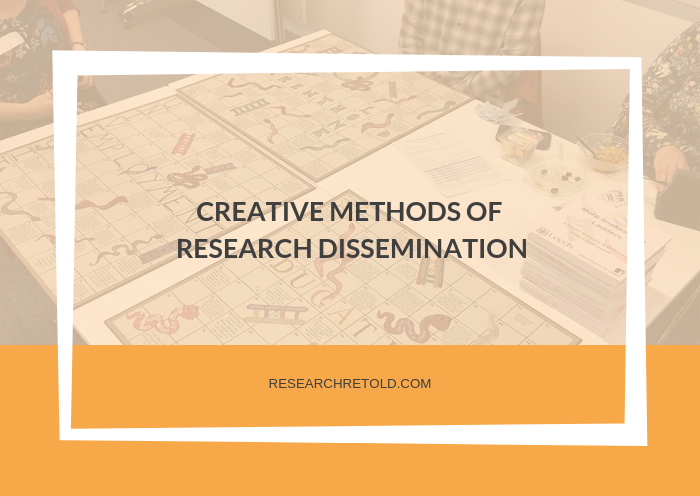In this blog post, we share four creative methods of research dissemination.
These are inspired by the knowledge café organised by the Social Research Association North.
The event was a collaboration with engage@liverpool at the University of Liverpool on 12 Sept 2019.
– – –
Whether you choose to engage audiences online or offline, researchers have several methods of disseminating findings at their disposal. However, choosing the most appropriate one for your project can be difficult. We can often be set in our ways, choosing to stick with what we know to do best.
This month the Social Research Association (SRA) North and engage@liverpool tackled this subject in a knowledge café aimed at ‘showcasing visual outputs designed to maximise impact or increase accessibility’.
The organisers encouraged participants to present ‘films, theatre, infographics, mixed media, computer models – in short, anything that is not a journal article or a 1:3:25 research report!’.
We were one of five teams on the day, among representatives from academia, government and the third sector.
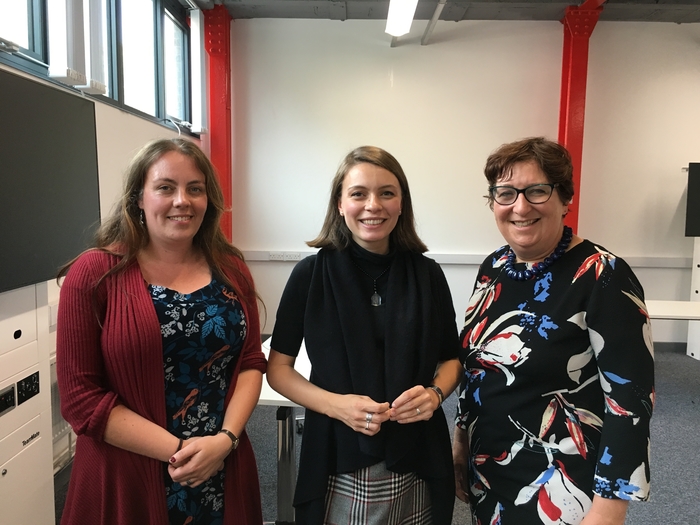
(From left to right: Dr Jenni Brooks, Mihaela Gruia, Bev Bishop)
What is a knowledge café?
A knowledge café can be used ‘to learn from each other, share ideas and insights and gain a deeper understanding of a topic and the issues involved’ (knowledge.café). It is a largely self-directed forum where participants share ideas. At the SRA North event, attendees spent 20 minutes with each group and then rotated around the groups in the room.
This gave everyone an opportunity to see the stalls and maximise their learning and networking.
The video below gives you a flavour of what the event was like:
Overall, I enjoyed the format and was delighted to learn about some unique methods of creative research dissemination from the other participants.
Creative methods of research dissemination
Creative method 1: Performative arts
Dr Alywyn Walsh from the University of Leeds conducts research that addresses the public understanding of people leaving the criminal justice system. For this, she collaborated with partners from the criminal justice sector to enrich the research.
At the event, Dr Walsh was accompanied by two arts and performance students at the University of Leeds. The two actors had observed a series of magistrate hearings and interviewed various people in the justice system. The point was to amalgamate the results into a character which then they performed. One was a youth offender and the other one was a social worker.
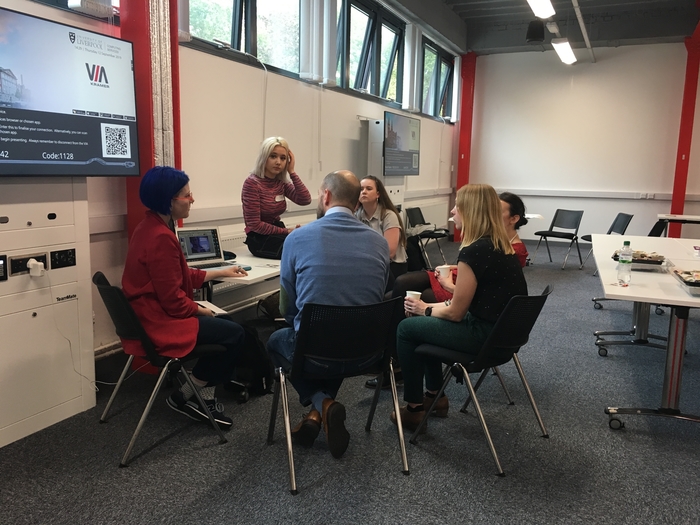
Using theatre to disseminate qualitative research can be a powerful tool. In fact, there has been an increase in using research-based theatre to bring education, history or health findings to life. One reason for its success could be the emotional attachment created which makes the audience care and pay attention.
When talking about how she used theatre to turn her ‘dry academic research into a compelling and emotionally engaging drama’ about the stories of revolutionary women who helped bring about the end of the First World War, Pf Ingrid Sharp says:
“A colleague told me that hearing my lecture had convinced him of the arguments I was putting forward, but only when he saw the play did he understand why it mattered so much: the stories of these women made him care.”
Pf Ingrid Sharp, Professor of German Cultural & Gender History
Two main collaboration methods are worth highlighting when using theatre as a creative research dissemination method.
First, the researchers can collaborate with students from the drama school of theirs or another university. In showing the creative possibilities around research dissemination, this approach can be powerful in inspiring young people to go into research. At the very least, they get to see that research is not an ‘ivory-tower’ endeavour and can relate to daily lives and experiences.
Second, researchers can collaborate with a local theatre company, such as Bent Architect. This approach is helpful to create links with external organisations and increase the impact of the research on society. Since theatre companies already have established distribution networks, they can help researchers reach a new audience. This is a powerful collaboration due to its impact-expanding possibilities and the chance to reach local communities who may not otherwise have heard about the research.
Overall, theatre is a powerful creative method of research dissemination. It is emotive, generates empathy and quite literally brings research to life in flesh and bones in a way that cannot be ignored.
Creative method 2: Participatory filmmaking
The next best thing after using theatre to disseminate research has to be creating a film. The opportunities created by having a short film to play about the research are endless.
At the event, we heard from two researchers who had used film as a creative research dissemination method.
- Dr Jenni Brooks, Sheffield Hallam University, showcased a movie about a research project that included people with dementia and telling their stories through ‘life story work’ (LSW).
LSW is “an intervention that aims to improve individual outcomes and care for people with dementia and their carers. LSW gathers information and artefacts about the person, their history and interests, and produces a ‘life story’” (Brooks et al, 2016).
Her research involved people living with dementia in a study exploring the feasibility of evaluating the use of LSW in dementia care.
To do this, she collaborated with Innovations in Dementia which ran a network of advisers with dementia who shaped the project at different stages over several years.
- Jessica Mitchell and Ines Soria-Donlan, University of Leeds, showcased a movie created by one of their Nepali communities as part of the Community Arts against Antibiotic Resistance in Nepal (CARAN) project.
CARAN uses participatory filmmaking and other arts-based approaches to find, document and share community-led solutions to antimicrobial resistance (AMR) in Nepal.
AMR is where common bugs are becoming immune to the drugs designed to kill them. Although AMR is a natural process it is becoming exacerbated by the overuse and misuse of antimicrobial medication and now represents a major global threat: common infections are becoming much harder to treat and contain.
The project introduces the concept of AMR and then challenges communities to explore their own experiences with this issue.
Participants working in small groups then expand a scenario into a story-board and short film to be shown within their local areas.
CARAN seeks to promote a more meaningful role for local communities in developing national health policy, using local knowledge to tailor international guidelines to the engagement with AMR across local communities.
Project partners included the Centre for World Cinemas and Digital Cultures, the Nuffield Centre for International Health and Development, HERD International, the Ministry of Health, Nepal.
Both examples show the power of filmmaking as a creative method of research dissemination. By involving local communities and giving a voice to groups who would otherwise not be heard, they are able to shed light on new experiences and create rich meaning from their work.
If you’re thinking of creating a movie for your research project, get in touch with your University’s media team. They usually have the technical and human resources available to help bring your project to life.
In addition, just like in the case of theatre, creating these collaborations across university teams broadens your network as a researcher.
Creative method 3: Board games
I must admit that before attending this knowledge café I had never before thought about this unique and creative method of research dissemination. I was pleased to meet Dr Gill Main from the University of Leeds who showcased a board game based on the experiences of people who manage their lives on a low income.
Their project operates as a direct response to the media and policy narratives around child poverty in the UK that tend to position children and families as ‘troubled’, unskilled, and a societal threat, They shed light on research findings that indicate that parents and children demonstrate few behavioural differences to their better-off peers.
Instead, they suffer from exclusion, bullying and stigmatisation. Moreover, children and families’ own knowledge and perspectives are absent from debates on what poverty is, how it impacts individuals and society and what interventions would be most useful.
The research team designed a ‘Snakes and Ladders’ game, based on experiences of poverty from the perspectives of children, young adults and parents, which is being played by a panel. This panel includes experts who have been trained in peer research and media communication. The audience playing the game are senior Council members, charity leaders and private sector organisations.
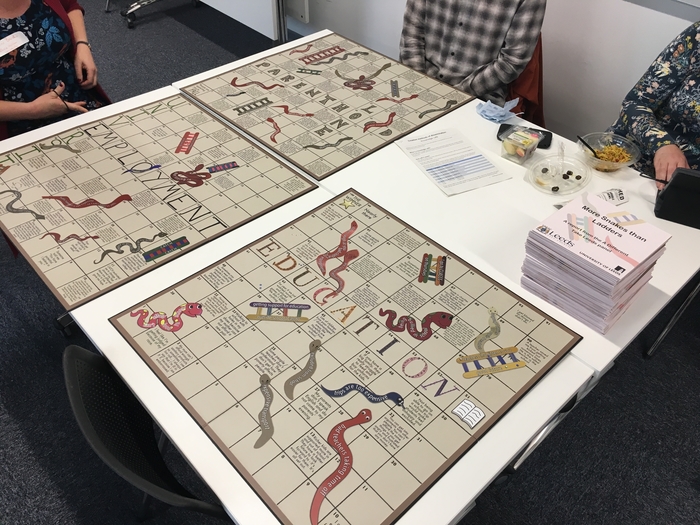
Project partners included Leeds City Council and The Child Poverty Action Group.
Everyone has played a game at some point in their lives. Using this format to relate to a very complex subject is a fantastic way to break down ideas into bite-size chunks. Moreover, because the project uses such a popular game concept, it appeals to our childhood and creates emotional experiences. The name of the game is ‘More snakes than ladders’ because living in poverty is an experience that offers more disadvantages than opportunities.
While this unique approach is hard to replicate, there are principles here worth keeping in mind about using games as creative methods of research dissemination.
First, it presents the ultimate simplification as it cuts to the core of the issue.
Second, it allows the use of real-life experiences and quotes to integrate into the play.
Third, it is universally ‘playable’, from juniors to the most senior of policy-makers.
Finally, it creates empathy and emotional attachment, thus, bringing a whole new dimension to the research findings that would otherwise risk being ignored if presented in a journal article.
Creative method 4: Infographics, illustrations and comics
The final of four creative methods of research dissemination was infographics.
Government statistician Ian Polanowski discussed how audience insight has led the statistics team in the Health and Safety Executive on a journey to transform their content.
He shared the journey of how his department slowly started implementing data visualisation practices to present their work.
“Communication that is clear and transparent is an essential part of Government research. It ensures that findings have the required impact with key stakeholders, from policymakers to the public.”
Ian Polanowski, Health and Safety Executive.
Clearly, we had a lot in common with Ian and his philosophy of clear communication. At the event, we showcased examples of projects we delivered for academic researchers in the form of infographics, illustrations and comics.
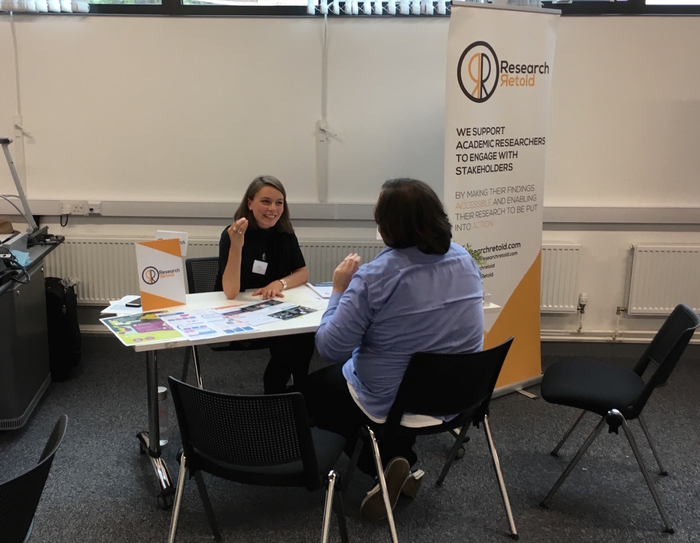
The main benefit of using these formats is being able to display research data in a much more digestible and visually appealing manner.
If your data is more quantitative, infographics can be a good fit for the findings. However, be careful not to simply place stats on a page using visuals, but to also create a narrative that accompanies the text and guides the reader through the document.
Moreover, if the data is qualitative in nature, then consider using an illustration or a comic. These formats can truly bring the research to life because they are typically character-based and often follow a storyline or a logical progression.
If you have any questions about how we can support you in creating a visual output based on your research, drop us a line at contact@researchretold.com or use the form below.
Overall, performative arts, participatory filmmaking, board games as well as infographics, illustrations and comics are 4 creative methods of research dissemination that are available to all and can truly bring research to life.
Many thanks to SRA North Chair, Dr Jenni Brooks, for inviting us to participate and we look forward to the next events. Keep up to date with the next SRA North events on Twitter @SRANorth!
References
Gridley, K., Brooks, J., Birks, Y., Baxter, K., Parker, G. (2016) Improving care for people with dementia: development and initial feasibility study for evaluation of life story work in dementia care, Health Services and Delivery Research, 4 (23)
